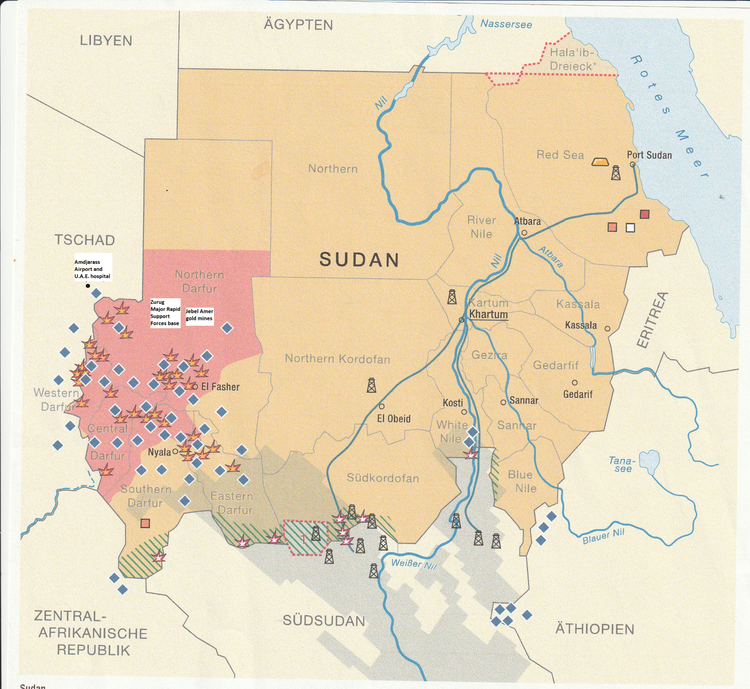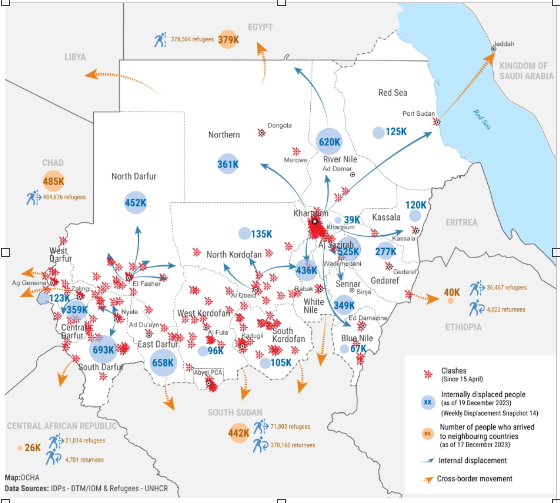Revolution and War in Sudan
January 9th, 2024 - written by: migration-control.info

Introduction
Why Sudan?
We would like to discuss why the recent developments in Sudan should be of high interest for all of us.
The Sudanese Revolution is one thing. The Resistance Committees, and the Revolutionary Charter make us think anew about revolutions. Committees like these could be the missing link between social uprisings and political structures.
And the war is now destroying the social fabric of the revolution. We think that it is important to know what is going on in Sudan at the moment, also in order to discuss if there is any chance that we can do aynthing about it.
As a start, please find here a short introduction on 5 topics which you should keep in mind when we are talking about Sudan.
***
Let me first remind you of the
Colonial Legacy.
The British took over in 1889 after winning a victory over an early islamic resistance movement, the army of the Mahdi. They brought in their latest rifles and cannons, and slaughtered thousands of the jihadists.
Then the British concentrated their direct rule on the Nile riverside, on Khartoum, and on the fertile plain between the Blue and the White Nile, Gezira. For the rest of Sudan, they preferred indirect rule, by strengthening the role of tribal leaders.
The British build some administrative structures only in Khartoum. They relied on the Riverside Tribes for building these structures. Out of these tribes came the ruling elite. Out of these families came the politicians, the generals, the clerics, and the entrepreneurs.
So, if we talk about politics in Sudan, we talk about what happens in Khartoum and an area within 1 days journey around the Triangular City. This was true until quite recently.
The periphery was marginalized and tribalized. Vast areas of the country, in particular the south and western regions, were designated as "spaces of extraction" under Muslim-Arab dominance. So opposition movements there mainly came as guerilla or warlord armies.
***

(Source: bpb)
The non-Arabized populations of these regions were racialized and suppressed. The
War in the South
between the State of Khartoum and rebel groups, was the longest running civil war in Africa, with 2 million humans killed and 4 millions displaced. This war also affected South Kordofan and the Nuba mountains, with relentless campaigns of violence there.
There was a ceasefire in the early 2000s which ended in the secession, 2011. For the Khartoum state, this led to an economic collapse, because the oil sources are mainly situated in South Sudan.
Also in the early 2000s, the Darfur conflict started, which led to 400 000 humans killed, and more than 2 million displaced. During this conflict, the Bashir regime relied on the Arab Janjaweed militias which burned down villages and massacred the population, together with the army. These groups are the roots of the RSF, and until 2018 this RSF got millions of Euros from EU for capturing refugees. Now Hemeti and his militia are part of the war in Sudan.
***
Let me say a few more sentences on
Displacement and Migration.
If you look at the map, you see all these blue Diamonds. These are refugee camps of the year 2017.
Besides the South Sudan and Darfur conflicts, there are so many drivers of displacement: Privatization and industrialization of agriculture (Gezira, then Nuba Mountains and Blue Nile), famine in Darfur and Kordofan, oil fields, dam construction, conflicts between pastoralists and peasants, which is also a driving force in Darfur.
Where did these people go to? Many fled into the Refugee camps, others went into informal settlements especially in the Triangular City.
While displacement and war were main drivers of migration, many more people went to the City in search for a better life. Especially in the years of the Oil Boom, 2000 – 2011, many young people and families moved to the city.
Added to this were the refugee movements from the HoA since the 1970s and 1980s.
So Khartoum came to be a city divided between the ruling and middle classes on the one side, and a growing class of Urban Poor people in the outskirts of the city. Khartoum was a melting pot, and we shall discuss which role the demonstrations and the Sit-In of 2019 played for the self-constitution of the Urban Poor as a Political Factor.
***
Let me say a few words about
Riots and Uprisings.
The Revolution of 1964 was a thing inside the ruling elite, no need to talk about this here.
It is more interesting to speak about the Intifada of 1985. The intifada started with student’s demonstrations, but one day later the Urban Poor population joined in, and there was a General strike and demonstrations in all major cities.
The Background of this intifada was a famine in the periphery, and IMF interventions which had led to higher bread- and fuel prices. It was like the same in several Maghreb countries. This “bargaining by riot” forced the regime in Sudan to keep prices relatively low over the years, also during the Bashir regime.
In 1985 the regime learned to control social uprising with staging the conflict as a political theatre. The dictator stepped down, there were elections, the traditional islamist parties won, some people enriched themselves, some islamist charity was installed, and 4 years later there was a new dictator who was to stay for 30 years. This is the scenario which the political elite, the clerics, the NIS, and the army, wanted to stage again in 2019. But at that time the movement was too strong, so they decided to make war.
From 1985 we jump to 2011. As you know, this was the year of the Arab Spring, and there were protests in universities and there were leftist bloggers also in Khartoum. But the Urban Poor did not join in for an uprising. For the Sudanese, 2011 is not the year of the Arab Spring, but the year of secession of South Sudan, and the year of economic collapse and renewed repression.
This was different in 2013: That was the year when the Urban poor rioted, and the Leftists were taken by surprise. Before anything could develop, the RSF stepped in and shot down 200 or so protesters. This was Hemeti's first appearance in Khartoum after his atrocities in Darfur.
The surprise of 2013 laid the gound for a new tendency in the Left: building links to the Urban Poor, and the workers, and into their neighbourhoods. This led to the Neighbourhood Committees which were so important in the Revolution of 2019.
***

(Source: OCHA)
Finally, let me show you a second map. It is a
Map of Displacement
from December 2023.
Behind all these atrocities is not only a war between two mad generals or a plan to destroy the revolution. Hemeti is well advised, he is a businessman and a modern alternative to the old islamist ruling class. You could compare him to Wallenstein in the 30 years war in Germany. Modernisation has gone hand in hand with mass murder and genocide many times in history.
Behind Hemeti and RSF stands the UAE Development Fund, among others, ready to develop harbours and some industry, to buy up the depopulated land, breed large herds of cattle in Darfur, or buy up the land around the new reservoirs along the Nile.
Also we must speak to you about the foreign interests and alignments in this war, and bring the topic back to Europe, back to Germany: Why has the EU supported Hemeti for such a long time? And what are the European interests now?
Timelines
Find a Timeline Sudan History EN here.